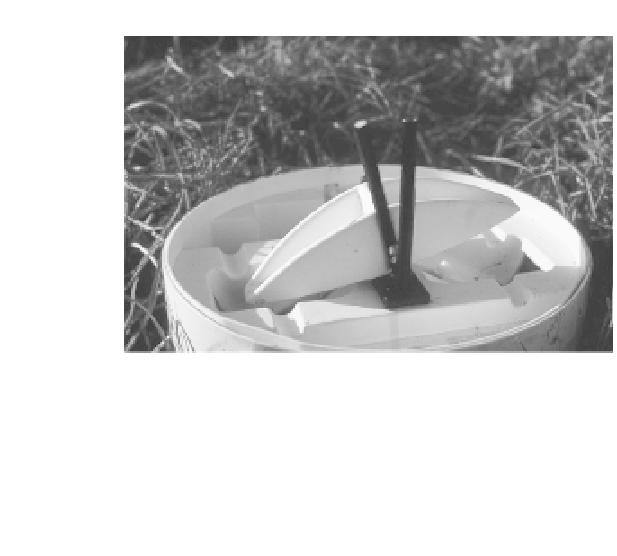Geoscience Reference
In-Depth Information
deposited on the gauge or ground. Most, although
not all, snowflakes are more easily transported by
the wind than raindrops. When the snow reaches
the ground it is easily blown around in a secondary
manner (drifting). This can be contrasted to liquid
water where, upon reaching the ground, it is either
absorbed by the soil or moves across the surface.
Rainfall is very rarely picked up by the wind again
and redistributed in the manner that drifting snow
is. For the snow gauge this presents problems that
are analogous to rain splash. For the depth gauge
the problem is due to uneven distribution of the
snow surface: it is likely to be deeper in certain
situations.
Figure 2.10
The insides of a tipping-bucket rain gauge.
The 'buckets' are the small white, triangular reservoirs.
These are balanced and when full they tip over bringing
the black arm past the other stationary arm. In doing so
a small electrical current is passed to a data logger.
Rain gauge modification to include
snowfall
One modification that needs to be made to a stand-
ard rain gauge in order to collect snowfall is a heated
rim so that any snow falling on the gauge melts to
be collected as liquid water. Failure to have a heated
rim may mean that the snow builds up on the gauge
surface until it overflows. Providing a heated rim is
no simple logistic exercise as it necessitates a power
source (difficult in remote areas) and the removal of
collected water well away from the heat source to
minimise evaporation losses.
A second modification is to raise the gauge well
above ground level so that as snow builds up the
gauge is still above this surface. Unfortunately
the raising of the gauge leads to an increase in the
turbulence errors described for rain gauges. For this
reason it is normal to have wind deflectors or shields
surrounding the gauge.
arm until it too tips the balance arm, sending
another electrical impulse to the data logger. In this
way a near continuous measurement of rainfall with
time can be obtained.
It is important that the correct size of tipping
bucket is used for the prevailing conditions. If the
buckets are too small then a very heavy rainfall
event will cause them to fill too quickly and water
be lost through overspill while the mechanism tips.
If the buckets are too large then a small rainfall
event may not cause the cross arm to tip and the
subsequent rainfall event will appear larger than it
actually was. The tipping-bucket rain gauge shown
in Figure 2.10 has an equivalent depth of 0.2 mm
of rain which works well for field studies in south-
east England.
Snowfall measurement
Snow depth
The measurement of snowfall has similar problems
to those presented by rainfall, but they are often
more extreme. There are two methods used for
measuring snowfall: using a gauge like a rain gauge;
or measuring the depth that is present on the
ground. Both of these methods have very large errors
associated with them, predominantly caused by the
way that snow falls through the atmosphere and is
The simplest method of measuring snow depth is
the use of a core sampler. This takes a core of snow,
recording its depth at the same time, that can then
be melted to derive the water equivalent depth.
It is this that is of importance to a hydrologist.
The major difficulties of a core sample are that it is
a non-continuous reading (similar to daily rainfall

